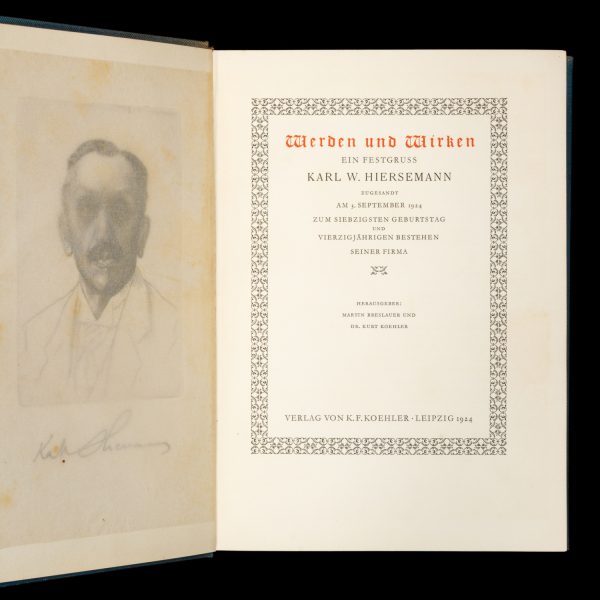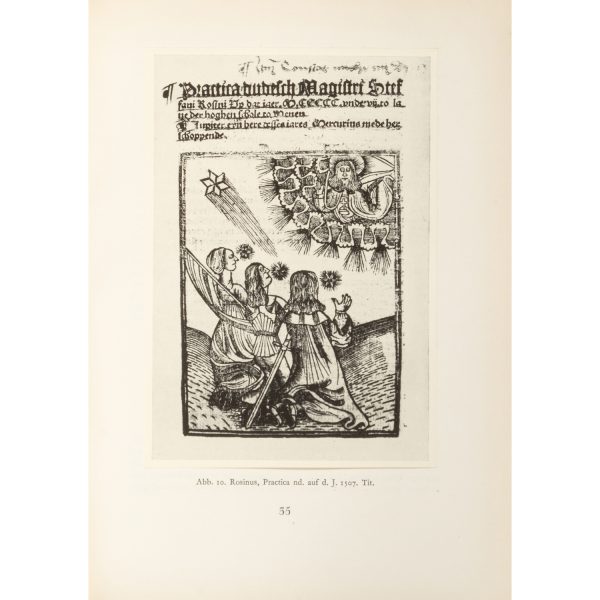# 43232
BRESLAUER, M. & KOEHLER, Kurt
[BOOKSELLING] Werden und Wirken : ein Festgruss Karl W. Hiersemann
zugesandt am 3. September 1924, zum siebzigsten Geburtstag und vierzigjährigen bestehen seiner Firma. Leipzig : Verlag von K.F. Koehler, 1924. Small quarto (270 x 200 mm), publisher’s blue cloth lettered in gilt (heavily sunned around head of spine); frontispiece etched portrait of Hiersemann by Gruner (with facsimile of Hiersemann’s signature), pp. [8], 421, [2], with 50 plates and illustrations (some tipped-in); one of 550 trade copies; internally excellent; loosely enclosed are a copy of The Publisher’s Circular and Booksellers’ Record (March 14, 1925), which contains an article on Hiersemann, and a German newspaper cutting with Hiersemann’s death notice.
A Festschrift for Karl Wilhelm Hiersemann (1854-1928), German printer, publisher and antiquarian bookseller.
Provenance: Henry George (1854, Bristol – 1938, London), a colleague of Hiersemann at Trübner & Co. in London in the 1870s, and later the London agent for Angus & Robertson 1904-1938 (pencilled inscription to this effect on the front pastedown).
Hiersemann decided to become a bookseller at the age of 13, and undertook several years of training in Leipzig at the booksellers’ college and at List & Francke (from October 1869 to spring 1874) and in Mannheim with J. Bensheimer. In 1876 he went to London to work at the antiquarian bookstores David Nutt and Trübner & Co. The present copy was given by Hiersemann himself to Henry George, a former colleague at Trübner. From 1881 Hiersemann worked at KF Koehler’s Antiquarium in Leipzig.
On his 30th birthday in 1884, he founded his own company in Leipzig under the name K. W. Hiersemann as a specialist bookstore for Orientalia, modern linguistics, art, architecture, decorative arts, numismatics and genealogy. Within just a few decades this became a leading international antiquarian bookstore with a worldwide reputation.
The company moved into its own commercial building at Goldschmidtstrasse 29 in Leipzig’s Graphic Quarter in 1909. By 1924, 540 catalogues had been published and more than 100 libraries had been purchased, including important collections such as Weigel’s collection of 84 manuscripts from the 9th to 16th centuries in 1905; the last antiquarian catalogue No. 669 was published during the Second World War. On the five floors of his business headquarters, Hiersemann maintained a rich warehouse of valuable books and exhibition rooms, as well as an extensive reference library and the work tool praised by colleagues: Hiersemann’s card catalogue of antiquarian titles with bibliographic descriptions and price information.
From 1892 onwards, the antiquarian bookstore developed into a scientific publishing house, the Anton Hiersemann Verlag, and an export bookstore was also attached to the antiquarian bookstore, which supplied libraries all over the world, especially in America and Russia.
Hiersemann’s contribution to society and to the book trade world was celebrated in Werden und Wirken, a commemorative publication published by Martin Breslauer and K. Koehler on his 70th birthday in 1924 – the same year he was awarded an honorary doctorate by the Hanover University of Technology.








